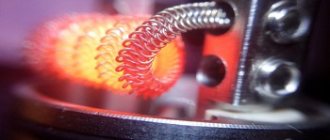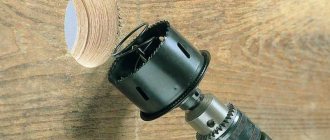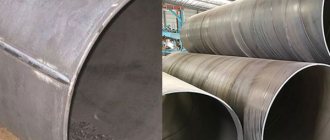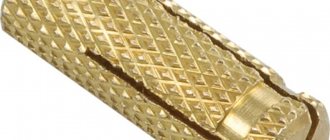A profile pipe is a hollow rod with a cross-section of the correct shape, different from a circle. It is used in various building structures, for the production of industrial equipment, instruments, furniture, etc.
Most often they are made from low-carbon and stainless steels with high plastic properties, or thermoplastics.
Features of profile pipes
Profile pipes differ from round pipes in their increased resistance to bending, compression, and torsion. This happens due to the fact that the walls that form the profile are kind of stiffening ribs that resist deformation when a load is applied.
To increase the strength of plastic pipes, they are made multilayer using reinforcing layers of fiberglass or aluminum foil.
The remaining physical, technical and operational properties: thermal stability, anti-corrosion, chemical resistance and durability differ little from round pipes made from similar materials.
More information about the range
Typically, profile pipes are classified into rectangular and square, which have different lengths and thicknesses. The material used is metal , which has been gradually replaced by plastic in recent years. Profile materials are used in various metal structures for various industries; they are an excellent alternative to bar construction. This is also facilitated by the rather low price and weight of the profile.
When installing structures, it is also necessary to choose the right profile metal product. It is necessary to correctly calculate the load-bearing capacity of the material, taking into account the possibility of using both rectangular and square profiles.
The mass and cross-section of a linear meter of each variety are also taken into account.
The most popular materials on the construction market are those pipes that have the following dimensions:
- 15 by 15;
- 20 by 20;
- 25 by 25;
- 30 to 30;
- 40 to 40;
- 60 to 60;
- 80 to 80;
- 100 to 100.
Types of profile pipes
They are divided according to several main characteristics:
- according to the material of manufacture;
- by profile and size;
- by production method.
Materials used
The most common are inexpensive steels deoxidized to a semi-quiet state with a low carbon content - from 0.08% to 0.45%.
Pipes coated with zinc or coated with powder paint are characterized by increased resistance to corrosion.
For especially high-quality pipes operating under conditions of increased loads and environmental influences, low-alloy steels 09G2S, 15ХМ and others are used in production.
Stainless steel grades AISI 316 and AISI 304 are resistant to elevated temperatures and have high anti-corrosion properties.
For rolled thermoplastics, polystyrene, polyethylene, polyvinyl chloride, and fiberglass are used.
Pipe profile
Types and sizes of profiles are regulated by relevant state standards.
The most commonly used standard profile shapes:
- Square - have greater resistance to bending compared to round pipes.
- Rectangular ones are also stronger than round ones. They have the greatest resistance to bending when the load is applied to the narrow part.
- Oval and flat-oval pipes are characterized by larger (A) and smaller (B) diameters. They are stronger than round ones if the load is directed to the narrow part.
Production of profile pipes
GOST 32931-2015 establishes the following manufacturing methods:
- hot rolling without seam;
- cold rolling without seam;
- welding with cold rolling;
- welding of steel strip.
Criterias of choice
The determining factors when choosing a suitable profile are: shape, section size, wall thickness and the material from which it is made. For the construction of load-bearing structures, preference is given to seamless square or rectangular corrugated pipes made of stainless alloy steel. Wall thickness and large size increase the strength of the profile. They must correspond to the design loads. If standard indicators are not met, the risk of deformation and even destruction of tubular products increases.
Types of profile pipes by manufacturing method
Hot rolled pipes
These products are made from a solid round billet.
Before rolling, it is heated to a temperature of 1200 °C, at which the steel softens and is “stitched” through with a special mandrel, forming a hollow sleeve. Next, the sleeve is passed through forming rollers, stretched and simultaneously rolled out on an internal mandrel.
The blank pipe obtained after rolling with the required dimensions passes through a group of vertical and horizontal calibrating rollers, taking on a given square, rectangular or oval cross-sectional shape.
The resulting finished product with specified external profile dimensions and wall thickness is cooled, after which it is cut to a specified length using special scissors.
To remove scale and oxide films, pipes undergo chemical etching followed by rinsing with hot and cold water.
After quality control inspection, the products are packed into bundles and delivered to the warehouse.
Cold rolled pipes
This type of rolled profile is produced in two ways:
- from a pre-cooled blank sleeve;
- from a finished round pipe.
In the first case, the technology is approximately the same, with the difference that the stitched sleeve is pre-cooled and subjected to etching and washing.
Then the workpiece enters the cold rolling mill, where it is also rolled out in sizing rolls, but with smaller reduction values, since cold metal requires more force to deform.
In the second case, a finished round pipe is used as a blank, which is rolled to obtain the desired shape and size.
Cold rolled welded pipes
The material for their manufacture is rolls of sheet steel, the so-called strips.
The strips enter a cutting machine, in which they are cut into long strips of the required width. The strips are wound on drums and fed to a forming mill, which uses rollers to bend the strip into a round tube with an open seam.
Depending on the design of the machine, the seam can be straight or spiral.
The workpiece is then transferred to the welding machine. To obtain a tight and uniform weld, its edges are compressed in the welding zone.
After the seam hardens, a “burr” is formed on both its surfaces - internal and external - - frozen extruded excess metal. The burr is cut off with a cutter while being cooled with a special emulsion.
The cooled billet then passes through a series of crimping rollers, which form a profile of a given cross-section.
The resulting continuous pipe is cut into pieces of the desired length. This manufacturing process is called a full cycle.
The last operation is quality control, which consists of examining the appearance and hardware flaw detection, which makes it possible to identify welding defects.
Welded steel strip pipes
They are manufactured by gradual bending of sheet metal on mandrels of appropriate shape and size.
Then the workpiece is welded along the seam and goes to calibration rollers for finishing the dimensions. In this way, small cross-section pipes with thin walls are produced.
To obtain pipes with improved characteristics, a tempering operation is performed. It consists of heating the resulting products to 200 - 300°C, followed by natural cooling in air.
Tempering relieves internal stresses, increases the homogeneity of the metal structure, its physical properties and strength.
Manufacturing of plastic pipes
The thermoplastic profile is made by extrusion followed by calibration.
If it is necessary to obtain a multilayer pipe, layering each type of thermoplastic on top of each other is used.
Areas of application
Profile pipes are widely used for the manufacture of various structures:
- frames of buildings, warehouses, light production modules, trade kiosks and pavilions, livestock farms, scaffolding, sports facilities, children's and playgrounds;
- parts of industrial and instrument equipment in mechanical engineering, aviation, shipbuilding, nuclear and other types of industry;
- shelving, office equipment and furniture;
- gates and metal doors, street structures - fencing, fences, public transport stops, billboards, banners, etc.
When choosing a brand of profiled steel, you need to strive for the optimal combination of its properties, characteristics and cost in relation to the conditions of use.
Seamless cold and hot rolled pipes have the greatest mechanical strength. Their main disadvantage is the highest cost.
Cold rolled pipes have a number of advantages compared to other types of rolled products:
- highest dimensional accuracy;
- greatest linearity along the length;
- lowest surface roughness;
- high corrosion resistance.
Thin-walled rolled products obtained by rolling out finished round pipes are used mainly in furniture production, office decoration and various decorative structures, where good appearance is valued and great strength is not required.
Plastic pipes, due to their high insulating properties, are used as cable channels for laying electrical wiring, ducts in ventilation systems, in the production of windows and furniture.
The most common types of profiles are pipes made from steel strip by welding and cold rolling; they are used in all branches of production and construction.
Their strength reaches 90–95% of the strength of seamless pipes.
Advantages: a very wide range, durability, low cost.
Advantages and disadvantages of profile rolled products
Compared to round pipes of similar sizes, profile pipes have a number of advantages:
- Increased bending resistance.
- Less weight and metal consumption.
- Simplicity of connecting pipes to each other, with frame sheathing and other parts using welding or bolted connections, which simplifies installation and assembly work.
- Good appearance.
- A variety of materials used in production.
In addition, the equipment on which they are produced has high productivity and a degree of automation, which allows reducing the cost of these products.
The disadvantage is the difficulty of using them as pipelines and gas pipelines for the following reasons:
- The pressure of liquids and gases on the walls of the profiles causes increased deformation compared to round pipes.
- All commercially produced connecting and shut-off pipeline fittings - couplings, valves, gate valves, valves, etc. Designed for use with round pipes.
- To bend profiles, special pipe benders are required.
- Higher cost.
Polypropylene
Advantages and disadvantages
This is perhaps the most popular material for internal water pipes now. At temperatures below 95 C, it perfectly performs its functions: the connections are not inferior in strength to a monolithic pipe, are easy to install, and polypropylene itself is not susceptible to corrosion and is non-electrically conductive.
The only disadvantage we can write down is the inseparability of welded joints.
Connection method: welding
Standards and sizes
The range of round pipes made of polypropylene in accordance with GOST 52134 can have a diameter of 10 mm and up to 1600 with walls thickness from 2 to 61 millimeters.
However, it should be borne in mind that this standard is not only for polypropylene: we are talking about all thermoplastic pipes.
A more realistic idea of the modern market is given by the pipe assortment on the website of one of the leading manufacturers of polypropylene pipes and fittings - Valtec.
There you can see:
- Pipes made of unreinforced polypropylene;
- Pipes made of polypropylene reinforced with aluminum, designed for pressures up to 25 bar;
- Glass fiber reinforced pipes with a working pressure of 20 bar;
- Glass fiber reinforced pipes with a working pressure of 25 bar.
The range of pipe diameters is from 16 to 90 millimeters.
Typical sizes and markings
Pipe sizes are determined by GOST 32931-2015:
- Square pipes are produced with a square side of 10 - 500 mm, wall thickness of 0.8 - 22 mm.
- Rectangular - with sides in a variety of combinations from 15x10 to 500x400 mm, walls 1.0 - 22 mm.
- Oval - with width (A) and height (B) from 6x3 to 90x32 mm, walls 0.5 - 2.5 mm.
- Flat oval - everything is the same, except that the wall thickness is 0.8 - 2.5 mm.
The delivery length depends on the manufacturing method:
- hot rolling without seam - from 3.0 to 12.5 m;
- cold rolling without a seam and welded with cold rolling - from 1.5 to 12.0 m;
- welded from steel strip - from 3.0 to 18.0 m.
The marking is applied to the surface of the product or to the label.
Marking example: PP pipe - 35x15x0.9x6000 - KP290 GOST 32931-2015, where:
- PP – rectangular profile;
- 35x15 – width and height, mm;
- 0.9 – wall thickness, mm;
- 6000 – length, mm;
- KP290 is a strength class that guarantees a yield strength of at least 290 N/mm².
In conclusion, we can say that, thanks to its many advantages, profiled steel is increasingly used, replacing the traditional construction profile assortment - angles, channels, rods.
It is also important that it can be independently used by people who do not have construction qualifications in the construction of country houses, fences and other household structures for personal use.
Transportation method from the metal depot to the required site
Rolled metal is usually produced up to 12 meters in length. Therefore, very often suppliers experience some difficulties when transporting this material.
For example, to transport a product 8-12 meters long, you need to use special cargo transport, which will cost a pretty penny.
The six-meter profile is the most common option. Delivery of such a structure must be done using a Gazelle, when one end is laid on a horizontal crossbar, and the other diagonally into the body. Using a Gazelle is much cheaper than transporting it by road.
You can always order the material to be cut, a six-meter profile will then turn out to be three meters, and in this case it will fit on the roof of any passenger car.











